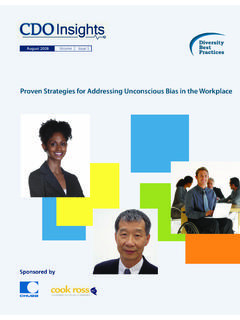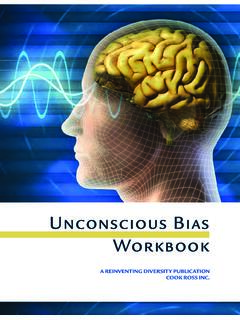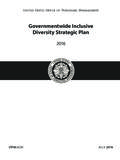Transcription of BIAS IN PERFORMANCE MANAGEMENT REVIEW …
1 bias IN PERFORMANCE MANAGEMENT . REVIEW PROCESS. creating AN inclusive TALENT PIPELINE BY UNDERSTANDING OUR. FILTERS. By Leslie Traub, Chief Consulting Officer at Cook Ross Inc. A Cook Ross Publication 2013. TABLE OF CONTENTS. About The Author 1. Executive Summary 2. A Brief Case Study 3. Unconscious bias and Talent MANAGEMENT 5. Rater bias 5. Mitigating Rater bias 7. Self-Rater bias 9. Mitigating Self-Rater bias 9. Structural bias 11. Mitigating Structural bias 12. Calibration bias 14. Mitigating Calibration bias 15. Who Is Responsible For Mitigating bias ? 16. LESLIE TRAUB. CHIEF CONSULTING OFFICER AND CHAIR OF THE BOARD. Exceptional facilitation and training, incomparable instructional design, powerful organizational change, impressive social science research, and transformative personal development these are the award-winning talents that Leslie Traub offers each Cook Ross client.
2 With more than 25 years of experience leading diversity, inclusion, and change MANAGEMENT initiatives, Leslie creates sustainable systems of change that yield greater PERFORMANCE , profit, Leslie Traub and possibility. Since joining Cook Ross in 1994, Leslie has developed an international reputation for leading systems based change in shifting an organization's lenses and practices on diverse talent, especially for women. She leads major engagements with financial and professional services, legal, energy, scientific organizations, and numerous federal agencies. Leslie has worked and lived in numerous cultures and countries. She brings this personal experience and passion to her work in cultural competence and cultural communication in her corporate, professional services, association, and not-for-profit consulting practice. Leslie spent the first 10 years of her career consulting to national primary health care programs in West Africa, conducting operations research on service delivery and national program evaluations.
3 Leslie has served as adjunct faculty for most of the universities in the Washington, DC area, as well as in other cities. Leslie holds a graduate certificate in Change MANAGEMENT from The Johns Hopkins University, a Masters in Biostatistics and Epidemiology from Tulane University, a in economics and history from Wheaton College in Massachusetts, and a Certificate in Training and Development from the University of Maryland. 1. EXECUTIVE SUMMARY. A traditional annual PERFORMANCE appraisal is the funnel through which employee talent is rewarded or penalized. Through this process, companies and organizations have the opportunity to increase the strength and diversity of their talent pipelines, and ensure success by promoting the strongest employees. This is an equally important process for employees, as it also is a time when their value to the company is validated and when the futures of their careers are determined.
4 With all of this understood, the fact remains that research in neuroscience has shown the powerful impact unconscious thinking processes can make upon our decisions. Our unintended, unconscious biases can create situations that permit us to make decisions that project our experiences and values onto others. When this sort of thinking is prevalent in talent MANAGEMENT processes, it can quickly reduce representational diversity. This article explains the four domains of bias in PERFORMANCE MANAGEMENT : rater bias , self-rater bias , structural bias , and calibration bias . Drawing upon a fictional case study based on years of real life consulting experience, we will explore how each bias manifests daily in the workplace, how each bias affects PERFORMANCE MANAGEMENT , and how we can mitigate these biases. By addressing and managing biases, organizations can provide equal growth opportunities for persons of all groups and ensure a robust team of employees necessary for success.
5 Cook Ross Inc. 2013. 2. A BRIEF CASE STUDY. S. tephanie is preparing for her Wilhelm was leaning toward rating second PERFORMANCE REVIEW at Stephanie as Above Expectations until Semantics, a global consulting he reviewed her self-assessment and firm. She is pleased with her 15 met with her one-on-one. In the REVIEW , months at the company, although they discussed Lunar Steel and the she sometimes feels intimidated status of some business development by those who grew up with the opportunities that were slow to close. organization. Even though she has He skirted any conversation about been in consulting for 12 years, she her career development opportunities views these Semantics consultants as because he did not want to put more really top shelf. In re-examining the pressure on her given her situation at competencies and contribution areas for home. Besides, he felt that Stephanie her level, and in light of the fact that seemed anxious to end the meeting.
6 She has had to scale back to 80 percent Afterward, in reflecting on the year, time because of her daughter's illness, he could feel the pressure to fit his Stephanie thinks she should fit squarely associates into a normal distribution, into Meets Expectations. which was very difficult because he had a lot of stars. He decided not to push Wilhelm, Stephanie's boss, collected for her promotion. input about Stephanie from her peers and project leads. From them, he During a REVIEW meeting in which all learned that Stephanie quickly grasped the division directors discussed their the Semantics consulting model, had consultants' ratings, Wilhelm gave great client relations, was responsible a synopsis of Stephanie's REVIEW for cross-selling services within another and his recommendation. Bill, one division to the tune of $ million, of Stephanie's client leads this year, and had her hand in several significant chimed in and said she was incredibly business development opportunities.
7 Focused, dedicated, productive, and came in under budget while significantly All told, the feedback he received was growing her project. He was surprised very positive. The only areas of concern she was not being considered for an were her speed in bringing to market Above Expectations rating. some innovative modeling ideas, and the fact that her most recent project Wilhelm noted that she recently went lead questioned her commitment to the part time. They moved on to the next company, given her decision to work candidate, Frans, another German who part time. Wilhelm himself had been had worked with Wilhelm for the past disappointed by her decision to work 4 years, who easily reached his Above part time this year. That said, he was Expectations rating without discussion, the one who encouraged her to do so and then onto the next. because he felt it was the right thing to do, especially with her husband on active military duty.
8 However, now that the firm really needs her on the Lunar Steel account, Wilhelm has to scale someone else up quickly, putting more work on his plate. 3. This fictitious case study that discusses the four domains of bias is based on a number of situations revealed over the past three years by Cook Ross clients. We know that in virtually every client service system, fulfilling a business strategy requires a finely honed and diverse employee base that reliably One of the exceeds the expectations of customers, vendors, and strategic partners. most important indicators Only with a broad, robust talent MANAGEMENT pipeline and an intentionally of pipeline unbiased leadership development selection process is this success possible strength is across organizational functions and levels. One of the most important the extent indicators of pipeline strength is the extent to which the organization is aware to which the of biases in the PERFORMANCE MANAGEMENT process.
9 Organization is aware of biases in PERFORMANCE Many global organizations openly claim that the profile and demographics of MANAGEMENT . their entry level population are a direct reflection of their desire to cultivate diversity. As we know, this mix diminishes greatly over time, often after just a few years. PERFORMANCE reviews that do not objectively reflect employee contributions are one of the main obstacles to retaining under-represented groups. When the PERFORMANCE REVIEW process is out of balance, opportunities for advancement narrow and in turn, narrow an organization's diversity pipeline. There are many dimensions to a PERFORMANCE REVIEW . Within each dimension there are just as many opportunities for bias , both negative and positive. Yet bias , in either positive or negative form, can compromise the objectivity of reviews and have real impact upon employee careers as well as the capacity of the company.
10 Thus, all approaches to managing PERFORMANCE can benefit from the exploration of the impact of bias in PERFORMANCE MANAGEMENT and career When an organization actively addresses its biases, it sends an important signal to a diverse workforce that real development and advancement opportunity is available. This paper will utilize the case study above to discuss the following four forms of bias : Manager or rater bias Self-rater bias Structural bias Calibration bias We will explore each bias , understand its manifestations and consequences, and identify mitigation strategies. 1 Although some organizations have innovative and potentially effective mechanisms for growing talent other than through an annual REVIEW ( , on-going coaching models, career dialogues with employees, etc.), this paper will focus on the traditional REVIEW process. Cook Ross Inc. 2013. 4. UNCONSCIOUS bias AND TALENT MANAGEMENT .








